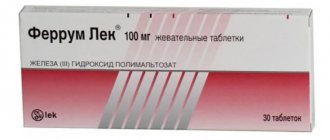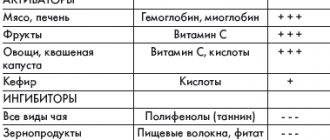Iron deficiency state (IDS, hyposiderosis) is a lack of total iron in the human body that does not meet current physiological needs. One of the special cases of manifestation of iron deficiency anemia (IDA) is iron deficiency anemia. Iron deficiency anemia is the most common form of anemia , laboratory confirmed by a decrease in hemoglobin content per unit volume of blood. A decrease in hemoglobin and anemia occurs as a result of iron deficiency. IDA is a clinical manifestation of a complete lack of iron reserves in the human body and is accompanied by dysfunction of all organs and systems due to insufficient oxygen supply to cells and a decrease in the synthesis of iron-containing enzymes.
Functions of iron in the body
The main studied processes occurring with the participation of iron include:
- blood cell formation;
- synthesis of hemoglobin and myoglobin;
- supplying body tissues with oxygen and evacuating carbon dioxide;
- synthesis of ATP (energy carrier molecules) from blood glucose;
- synthesis of cytochromes (P450) and enzymes (catalases) - natural antioxidants involved in the processing of drugs, xenobiotics and the removal of hydrogen peroxide;
- DNA synthesis;
- participation in the regeneration of cells and tissues;
- synthesis of hormones and neurotransmitters;
- regulation of thyroid function;
- regulation of immune system function;
- participation in the processes of physical and psychomotor development.
What iron supplements are there?
Iron in preparations can be represented by a di- or trivalent ion, designated Fe2+ or Fe3+, which is part of salts or complex complexes (for example, polymaltose complex hydroxide).
When using iron salts, you may encounter problems with its absorption. Unfortunately, not all iron from the drug is absorbed in the gastrointestinal tract. Moreover, this process is poorly controlled, since it depends on the state of the gastrointestinal tract, food taken, and other medications. Therefore, both a lack of incoming iron and an overdose are possible. In addition, not all forms of medication are convenient to use; if some tablets are chewed, the enamel of the teeth is often stained and a metallic taste remains in the mouth for a long time. Trivalent iron preparations usually do not have these side effects.
Main causes of iron deficiency
In a number of cases, there are signs of iron deficiency in the body, ultimately leading to anemia. The most common causes of low iron levels include the following:
- reduced dietary intake;
- pathology of element absorption in the intestine;
- presence of chronic blood loss;
- increased iron requirements during pregnancy;
- excess polyphenols in food (for example, when drinking green tea or coffee);
- large blood losses due to injuries.
The group at increased risk of developing iron deficiency includes premature babies and children whose diet is deficient in iron, teenage girls, and those at the beginning of menstruation. A special category of people with anemia includes pregnant women, whose need for iron increases many times over. Blood donors may also notice signs of iron deficiency.
Low iron levels are common among vegetarians due to inadequate dietary intake of the element. In people with diseases of the digestive system, as well as with the development of chronic infectious diseases, anemia develops due to impaired absorption of iron by the digestive system.
It should be borne in mind that anemia is not always a harmless and easily corrected condition. Quite serious chronic diseases are often hidden under the mask of a lack of iron in the blood .
Anemia is often one of the symptoms of cardiovascular diseases, chronic diseases of the urinary system, a manifestation of malabsorption syndrome (or impaired intestinal absorption function). Anemia in women can occur with heavy menstrual bleeding. Other dangerous pathologies accompanied by iron deficiency in the blood are cancer and chronic inflammatory processes in the intestines.
Why?
A deficiency of an element is provoked by:
- Unbalanced diet. This is an imbalance of calories consumed and nutrients. Excessive consumption of salt, “fast carbohydrates” (sausage, carbonated drinks, cakes, pastries), exclusion of greens, vegetables, fruits, and animal products from the diet contribute to a deficiency of vitamins and minerals in the body, including iron.
- Incompatibility of consumed products. Herbert Shelton also spoke about the correct combination of foods. It has been proven that iron does not combine well with calcium (milk, cottage cheese), with caffeine (tea, coffee), but is perfectly absorbed with vitamin C (rose hips, citrus fruits) and folic acid (spinach, flaxseed oil).
- Intense physical activity (professional sports). With intense and prolonged physical activity, more iron is required (it is released with products of the excretory system and is spent on muscle growth and increased blood volume).
- Pregnancy and lactation. While carrying and feeding a child, the need for vitamins and microelements increases, since in addition to the required daily norm for the mother, a certain norm for the baby is also required.
- Active growth (transitional periods in the development of a child). With active growth, body weight increases, the immune system develops, etc. These processes are associated with a high need for vitamins and minerals, in particular iron.
- Blood loss. Significant blood loss can occur during operations, bleeding disorders, and internal bleeding. Heavy menstruation and frequent blood loss can also cause iron deficiency. With any blood loss, the body is deprived of important red blood cells. If the blood loss is hidden, the situation may not turn out well (in patients with hemophilia, for example, there are internal joint bleedings, it is difficult to detect them in time, and if the dose of the drug to control coagulation is chosen incorrectly, then such blood losses are life-threatening).
- Oncological diseases. With constant growth, cancer cells consume all the body's available resources, including iron reserves.
- The body's inability to absorb iron. It happens that, despite a sufficient intake of iron from food, its deficiency is still detected. This is due to a violation of its absorption, and the reason is chronic diseases of the gastrointestinal tract (gastritis, colitis, dysbacteriosis).
Symptoms of iron deficiency
The classic clinical signs of iron deficiency are:
The patient complains of fatigue and fatigue even from the usual load. The main reason is the insufficient supply of oxygen to the cells and tissues of the body. Weakness and lack of endurance are also due to the fact that iron is involved in the production of energy in the form of ATP molecules. In the absence of sufficient oxygen, muscle tissue switches to anaerobic mechanisms for producing ATP, which is less efficient and more taxing on the body. Other common symptoms of anemia include mood swings and irritability . The mechanism of this process is as follows: a lack of iron in the body disrupts the production of the neurotransmitter dopamine and thyroid hormones, which leads to hypothyroidism. Hence the feeling of anxiety, stress, irritability and mood swings.- The next symptom of iron deficiency is decreased concentration . As you know, oxygen is one of the factors that ensures the activity and high performance of the brain. Its deficiency in anemia is the cause of impairment of the subtle cognitive functions of the brain. Many patients with low iron levels in the body experience attacks of dizziness. Frequent dizziness is also the result of a lack of oxygen in red blood cells. The same series of symptoms of anemia include unexplained frequent headaches. Lack of iron leads not only to a decrease in hemoglobin content, but also disrupts the formation of another iron-containing protein - myoglobin. This leads to soreness and tension in the muscles of the face, neck and shoulders, which explains frequent headaches in iron deficiency.
A number of patients with anemia complain of sleep disturbances . Ferritin, the main protein that stores iron, is one of the most important regulators of sleep. Insomnia in iron deficiency occurs when iron reserves are depleted at the earliest stages of the pathological process, since ferritin is the first to disappear.- Visible changes in anemia in men and women occur in the skin and nails : the surface of the lips looks dry and cracked, the nails become brittle and longitudinally striated. Ferritin is an essential component necessary for the normal processes of tissue regeneration and renewal, especially the skin and its appendages (hair, nails). Depletion of ferritin stores leads to deterioration of cellular repair processes in these tissues. The skin and mucous membranes of patients with anemia are usually pale, this is especially noticeable when hemoglobin drops below 90 g/l. First of all, those areas where the blood flow is closest to the surface of the skin or mucous membrane turn pale: lips, conjunctiva, palms, nail beds.
- , restless legs syndrome or Willis-Ekbom disease may occur A deficiency of the element in the body leads to an imbalance between the synthesis of dopamine and the metabolism of thyroid hormones. To make such a diagnosis, the presence of 4 main signs is necessary: the need to move the legs to overcome unpleasant sensations in the limbs;
- unpleasant sensations in the legs arise and intensify at rest;
- unpleasant sensations partially or completely disappear in an active state (running, walking);
- the need to move the legs and discomfort intensify in the evening and often cause insomnia.
How to recognize anemia?
Typical symptoms of anemia caused by hypoxia of organs and tissues are dizziness, fatigue, weakness, tinnitus, shortness of breath when climbing stairs, decreased performance. There is also a decrease in appetite, pale skin (in some cases yellowing), and “stubs” in the corners of the mouth. Hair may begin to fall out and the condition of nails may deteriorate. In addition, the mood changes and apathy and irritability appear, even if everything is fine.
If you notice such changes, do not rush to take iron or vitamin supplements or take B12 injections. The doctor gives a conclusion about anemia based on laboratory parameters. And taking medications on your own can be unsafe.
Diagnosis of iron deficiency
Currently, several laboratory tests have been developed to diagnose iron deficiency. The main ones include determining the following blood parameters:
- the amount of serum iron;
- indicator of total iron-binding capacity of serum (TIBC);
- transferrin iron saturation percentage;
- ferritin amount;
- amount of hemoglobin.
It is important to understand that it is a big mistake to prescribe iron supplements solely based on the results of determining low ferritin. In the presence of a MTHFR mutation that disrupts the processing and absorption of iron, folic acid, and vitamin B12, ferritin is always low and serum iron is high, which does not allow prescribing iron supplements to such patients.
The goals of laboratory tests for iron deficiency anemia are:
- identification of disturbances in iron metabolism;
- determination of the nature of anemia;
- assessing the risk of developing iron overload in the body.
Preparation for laboratory tests for anemia is simple and fairly standard. It is necessary to donate blood in the morning, strictly on an empty stomach (with an 8-hour break after eating). The day before testing, you must stop taking iron supplements and/or multivitamins. If radioisotope diagnostics were carried out the day before, the study of iron metabolism should begin no earlier than 4-5 days after its completion. It is also important to consider that some medications may interfere with test results. For example, estrogen or oral contraceptives can increase TBI, while corticosteroids and testosterone, on the contrary, lower TBI.
What foods contain iron?
To get the required amount of iron, you need to eat foods that contain it. For humans, the most valuable iron is heme iron, which contains myoglobin and is present in foods of animal origin. The following products contain it:
- beef liver and other offal;
- beef;
- fish;
- turkey;
- seafood.
Another microelement is obtained from beets, buckwheat, pomegranates and apples. They contain non-heme iron, which is absorbed much worse than heme iron. The leader in content per 100 g here is buckwheat. Moreover, for better absorption it should not be boiled, but steamed overnight by pouring boiling water over it. It is also useful to additionally include foods with vitamin C in your diet, as it helps iron to be absorbed more efficiently.
On this topic:
Benefits of vitamin C for the body | Does it really help against colds and why is it needed in sports?







